Hey Guys, here goes the question.
Of the students who eat in a certain cafeteria, each student either likes or dislikes lima beans and each student either like or dislikes Brussels sprouts. Of theses students, 2/3 dislike lima beans; and of those who dislike lima beans; 3/5 also dislike Brussels sprouts. How many of the students like Brussels sprouts but dislike lima beans?
(1) 120 students eat in the cafeteria
(2) 40 of the students like lima beans.
For me both option are not sufficient. Alas it's the contrary. Can you explain me why?
Cheers
Lukas
cafeteria
This topic has expert replies
-
lukaswelker
- Senior | Next Rank: 100 Posts
- Posts: 65
- Joined: Wed Mar 26, 2014 6:56 am
- Followed by:1 members
GMAT/MBA Expert
- Brent@GMATPrepNow
- GMAT Instructor
- Posts: 16207
- Joined: Mon Dec 08, 2008 6:26 pm
- Location: Vancouver, BC
- Thanked: 5254 times
- Followed by:1268 members
- GMAT Score:770
We can use the Double Matrix Method to solve this question. This technique can be used for most questions featuring a population in which each member has two characteristics associated with it.lukaswelker wrote: Of the students who eat in a certain cafeteria, each student either likes or dislikes lima beans and each student either like or dislikes Brussels sprouts. Of theses students, 2/3 dislike lima beans; and of those who dislike lima beans, 3/5 also dislike Brussels sprouts. How many of the students like Brussels sprouts but dislike lima beans?
(1) 120 students eat in the cafeteria
(2) 40 of the students like lima beans.
Here, we have a population of students, and the two characteristics are:
- like Brussels sprouts or dislike Brussels sprouts
- like lima beans or dislike lima beans
So, we can set up our diagram as follows:
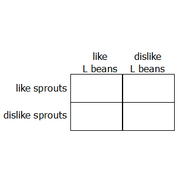
Target question: How many of the students like Brussels sprouts but dislike lima beans?
Let's place a STAR in the box representing those students who like Brussels sprouts but dislike lima beans.
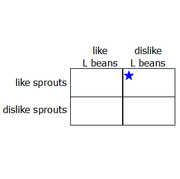
Since we don't know the TOTAL NUMBER of students, let's let x represent the total student population. So, we'll add that to our diagram as well.
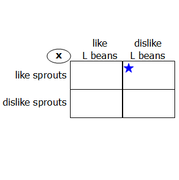
Given: 2/3 dislike lima beans
So, (2/3)x = total number of students who dislike lima beans
This means the other 1/3 LIKE lima beans. In other words, (1/3)x = total number of students who LIKE lima beans.
We'll add that to the diagram:
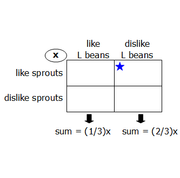
Given: Of those who dislike lima beans, 3/5 also dislike Brussels sprouts
If (2/3)x = total number of students who dislike lima beans, then (3/5)(2/3)x = total number of students who dislike lima beans AND dislike Brussels sprouts.
(3/5)(2/3)x simplifies to (2/5)x, so we'll add that to our diagram:
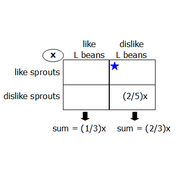
Finally, since the two boxes in the right-hand column must add to (2/3)x, we know that the top-right box must = (4/15)x [since (2/3)x - (2/5)x = (4/15)x]
So, we can add that to the diagram:
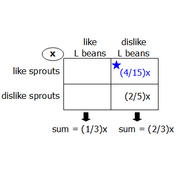
Great! We're now ready to examine the statements.
Statement 1: 120 students eat in the cafeteria
In other words, x = 120
Plug x = 120 into the top-right box to get: (4/15)(120) = 32
So, there are 32 students who like Brussels sprouts but dislike lima beans.
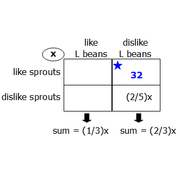
Since we can answer the target question with certainty, statement 1 is SUFFICIENT
Statement 2: 40 of the students like lima beans.
The left-hand column represents students who like lima beans.
In total, (1/3)x = total number of students who LIKE lima beans.
So, statement 2 is telling us that (1/3)x = 40
We can solve the equation to conclude that x = 120
Once we know the value of x, we can determine the number of students who like Brussels sprouts but dislike lima beans (we already did so in statement 1)
Since we can answer the target question with certainty, statement 2 is SUFFICIENT
Answer = D
------------------------------
To learn more about the Double Matrix Method, watch our free video: https://www.gmatprepnow.com/module/gmat- ... ems?id=919
Once you're familiar with this technique, you can attempt these additional practice questions:
Easy Problem Solving questions
- https://www.beatthegmat.com/the-aam-aadm ... 72242.html
- https://www.beatthegmat.com/finance-majo ... 67425.html
Medium Problem Solving questions
- https://www.beatthegmat.com/probability- ... 73360.html
- https://www.beatthegmat.com/posted-speed ... 72374.html
- https://www.beatthegmat.com/motel-t271938.html
- https://www.beatthegmat.com/of-the-appli ... 70255.html
- https://www.beatthegmat.com/opening-nigh ... 64869.html
- https://www.beatthegmat.com/ds-french-ja ... 22297.html
Difficult Problem Solving questions
- https://www.beatthegmat.com/ratio-problem-t268339.html
- https://www.beatthegmat.com/overlapping- ... 65223.html
- https://www.beatthegmat.com/fractions-t264254.html
- https://www.beatthegmat.com/overlapping- ... 64092.html
- https://www.beatthegmat.com/mba/2011/05/ ... question-2
Easy Data Sufficiency questions
- https://www.beatthegmat.com/for-what-per ... 70596.html
- https://www.beatthegmat.com/ds-quest-t187706.html
Medium Data Sufficiency questions
- https://www.beatthegmat.com/sets-matrix-ds-t271914.html
- https://www.beatthegmat.com/each-of-peop ... 71375.html
- https://www.beatthegmat.com/a-manufacturer-t270331.html
- https://www.beatthegmat.com/in-costume-f ... 69355.html
- https://www.beatthegmat.com/mba/2011/05/ ... question-1
Difficult Data Sufficiency questions
- https://www.beatthegmat.com/double-set-m ... 71423.html
- https://www.beatthegmat.com/sets-t269449.html
- https://www.beatthegmat.com/mba/2011/05/ ... question-3
Cheers,
Brent
- GMATGuruNY
- GMAT Instructor
- Posts: 15539
- Joined: Tue May 25, 2010 12:04 pm
- Location: New York, NY
- Thanked: 13060 times
- Followed by:1906 members
- GMAT Score:790
This is an EITHER/OR group question.Of the students who eat in a certain cafeteria, each student either likes or dislikes lima beans, and each student either likes or dislikes brussel sprouts. Of these students, 2/3 dislike lima beans; and of those who dislike lima beans, 3/5 also dislike brussel sprouts. How many of the students like brussels sprouts but dislike lima beans?
(1) 120 students eat in the cafeteria
(2) 40 students like lima beans.
Every student EITHER dislikes lima beans OR likes lima beans.
Every student EITHER dislikes brussels sprouts OR likes brussels sprouts.
For an EITHER/OR group problem, use a GROUP GRID to organize the data.
Let DL = dislikes limas, LL = likes limas, DB = dislikes brussels sprouts, and LB = likes brussels sprouts.
There are two fractions in the question stem: 2/3 and 3/5.
Since the product of the denominators = 3*5 = 15, let the TOTAL = 15x.
Here's the grid:
Now let's use the information in the question stem to complete as much of the grid as possible._______________DL______LL_______Total
DB:
LB:
Total:___________________________15x
Values in the grid have to add up horizontally and vertically.
As soon as we know 2 entries in a row or a column, we can calculate the remaining entry in that row or column.
2/3 dislike lima beans:
Since (2/3)(15x) = 10x, we get:
Of those who dislike lima beans, 3/5 also dislike brussel sprouts._______________DL______LL_______Total
DB:
LB:
Total:__________10x______5x_______15x
Since (3/5)(10x) = 6x, we get:
The question stem asks for the number of students who like brussels sprouts but dislike lima beans: 4x._______________DL______LL_______Total
DB:____________6x_______________
LB:____________4x_________________
Total:_________10x______5x_______15x
To determine the value of 4x, we need to know the value of x.
Question rephrased: What is the value of x?
Statement 1: 120 students eat in the cafeteria
Since the total number of students = 15x, we get:
15x = 120
x = 8.
SUFFICIENT.
Statement 2: 40 students like lima beans.
Since the total number of students who like lima beans = 5x, we get:
5x = 40
x = 8.
SUFFICIENT.
The correct answer is D.
Last edited by GMATGuruNY on Fri Aug 15, 2014 5:56 am, edited 1 time in total.
Private tutor exclusively for the GMAT and GRE, with over 20 years of experience.
Followed here and elsewhere by over 1900 test-takers.
I have worked with students based in the US, Australia, Taiwan, China, Tajikistan, Kuwait, Saudi Arabia -- a long list of countries.
My students have been admitted to HBS, CBS, Tuck, Yale, Stern, Fuqua -- a long list of top programs.
As a tutor, I don't simply teach you how I would approach problems.
I unlock the best way for YOU to solve problems.
For more information, please email me (Mitch Hunt) at [email protected].
Student Review #1
Student Review #2
Student Review #3
Followed here and elsewhere by over 1900 test-takers.
I have worked with students based in the US, Australia, Taiwan, China, Tajikistan, Kuwait, Saudi Arabia -- a long list of countries.
My students have been admitted to HBS, CBS, Tuck, Yale, Stern, Fuqua -- a long list of top programs.
As a tutor, I don't simply teach you how I would approach problems.
I unlock the best way for YOU to solve problems.
For more information, please email me (Mitch Hunt) at [email protected].
Student Review #1
Student Review #2
Student Review #3
-
susahntgupta402
- Newbie | Next Rank: 10 Posts
- Posts: 5
- Joined: Tue Apr 08, 2014 2:23 pm
lets say total number is 300 (why, because we have first denominator as 3 so 300 will give you a number multiple of 100 and hence easy to calculate).
Total DLB = 300*2/3 = 200
Total DLB + DBS = 200 *3 /5 = 120
Total DLB + LBS = DLB - (DLB+DBS) = 200 - 120 = 80.
This means if we know total number of students eating in cafeteria we will be able to tell the number of students who DLB but LBS.
Option 1 : 120 students eat in the cafeteria - Sufficient (based on conclusion drawn above)
Option 2 : 40 of the students like lima beans - Sufficient (since each student either like or dislike LB we can easily get the number of student who dislike lima bean and hence the total number of students)
Total DLB = 300*2/3 = 200
Total DLB + DBS = 200 *3 /5 = 120
Total DLB + LBS = DLB - (DLB+DBS) = 200 - 120 = 80.
This means if we know total number of students eating in cafeteria we will be able to tell the number of students who DLB but LBS.
Option 1 : 120 students eat in the cafeteria - Sufficient (based on conclusion drawn above)
Option 2 : 40 of the students like lima beans - Sufficient (since each student either like or dislike LB we can easily get the number of student who dislike lima bean and hence the total number of students)
GMAT/MBA Expert
- Jeff@TargetTestPrep
- GMAT Instructor
- Posts: 1462
- Joined: Thu Apr 09, 2015 9:34 am
- Location: New York, NY
- Thanked: 39 times
- Followed by:22 members
Solution:lukaswelker wrote:Hey Guys, here goes the question.
Of the students who eat in a certain cafeteria, each student either likes or dislikes lima beans and each student either like or dislikes Brussels sprouts. Of theses students, 2/3 dislike lima beans; and of those who dislike lima beans; 3/5 also dislike Brussels sprouts. How many of the students like Brussels sprouts but dislike lima beans?
(1) 120 students eat in the cafeteria
(2) 40 of the students like lima beans.
For me both option are not sufficient. Alas it's the contrary. Can you explain me why?
Cheers
Lukas
The easiest way to solve this problem is to set up a double set matrix. In our matrix we have two main categories: lima beans and Brussels sprouts. More specifically, our table will be labeled with:
1) Likes lima beans (Like LB)
2) Dislikes lima beans (Dislike LB)
3) Likes Brussels sprouts (Like BS)
4) Dislikes Brussels sprouts (Dislike BS)
(To save room on our table headings we will use the abbreviations for these categories)
We are not given the total number of students in the question stem, so we label the total number of students as T.
Thus, we know:
Total students = T
Dislikes lima beans = (2/3)T
We are next given that of those who dislike lima beans, 3/5 also dislike Brussels sprouts. Thus we can say that (3/5)(2/3)T = (2/5)T dislike lima beans and dislike Brussels sprouts.
We are trying to determine the number of the students who like Brussels sprouts but dislike lima beans.
Let's fill all this information into a table. Note that each row sums to create a row total, and each column sums to create a column total. These totals also sum to give us the grand total, designated by T at the bottom right of the table.

Since (4/15)T represents the number of students who like Brussels sprouts but dislike lima beans, we see that if we know the value of T, then we can determine the number students who like Brussels sprouts but dislike lima beans.
Statement One Alone:
120 students eat in the cafeteria.
We see that T = 120. Since we have a value for T, we can determine the number students who like Brussels sprouts but dislike lima beans. Statement one alone is sufficient. We can eliminate answers B, C, and E.
Statement Two Alone:
40 of the students like lima beans.
From looking at our chart, we see that (1/3)T students like lima beans. Thus we can say:
(1/3)T = 40
T = 120
Once again, because we have a value for T, we can determine the number of students who like Brussels sprouts but dislike lima beans. Statement two alone is sufficient.
The answer is D
Jeffrey Miller
Head of GMAT Instruction
[email protected]

See why Target Test Prep is rated 5 out of 5 stars on BEAT the GMAT. Read our reviews




















